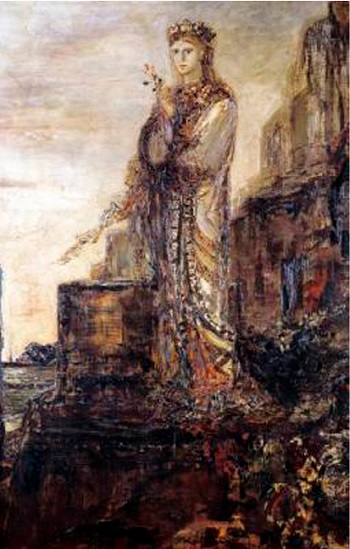1.2 Herodotus’ opening pitch (1.1.1)
The Wikipedia entry which you read in Activity 2 informed us that Herodotus is known as ‘the first writer to perform systematic investigation of historical events’. You’ll begin by examining this claim, by thinking about what kind of (ancient Greek) literature came before Herodotus. To better understand what Herodotus is doing, you’re going to compare Herodotus’ introduction to the beginning of Homer’s Iliad.
Homer’s Iliad is a poem on an epic scale (it is 15,693 lines long!). One of the first complete works of ancient Greek literature to have come down to us, in fact the Iliad stands at the end of a long oral tradition of song stretching back centuries. These songs star a mythical generation of hero men and preserve their exploits for future fame (kleos). At the same time, epic poetry provided Greek audiences with a shared past and a sense of how their current world came into being.
From around a generation before Herodotus (i.e. some time in the sixth century BCE), two of these epics, Homer’s Iliad and Odyssey, became incorporated into the repertoire of an important panhellenic (‘all Greek’) festival put on by the Athenians every four years: the Great Panathenaia – an ‘all Athenian’ cultural festival of sport, dance, drama and poetry. Soon after, both Homeric poems become fixed in form and content by being written down, which is why they have survived and other epic poems have not. With the advent of writing, there was an information explosion in the Greek world, as a new wave of thinkers took to recording in prose all kinds of things: how the natural world worked; how and why people got ill; what different lands and peoples looked like, etc. Among this group of radical thinkers is Herodotus.

In the next activity you will read a short passage from the Iliad. There are many aspects that may well appear odd or confusing. For example, Homer refers to several gods worshipped by the ancient Greeks – Hades, the god of the underworld; Zeus, the leader of the gods; and Apollo (‘the son of Leto and Zeus’). Homer also uses unfamiliar terms – labels such as ‘the Achaeans’ to mean the Greeks who fought at Troy or the ‘son of Atreus’ to mean Agamemnon.Try not to let these unfamiliar aspects put you off: your task is about extracting specific information.
Activity 3
Compare the opening lines of Herodotus’ Histories and the Iliad. Reading them as many times as you need, answer the questions in the table below, jotting down a short sentence or phrase to sum up your thoughts.
| Question | Homer’s Iliad | Herodotus’ Histories |
|---|---|---|
| What do we learn about the author of each work? | ||
| What will the work be about? Try to find three things. |
Homer, Iliad 1.1-8 [Book 1, lines 1-8]
About the wrath of Peleus’s son Achilles, sing goddess,
a destructive wrath that put a myriad of hurt on the Achaeans,
and sent into Hades the many mighty souls
of heroes, and made them food for all kinds of dogs
and birds; and the will of Zeus was being accomplished,
from that time when the two of them first stood apart in strife,
Son of Atreus, lord of men, and godlike Achilles,
Which one of the gods brought them together in strife?
The son of Leto and Zeus: for he was angry with the king...
Herodotus, Histories 1.1.1
This is the display of the enquiry (historiē) of Herodotus the Halicarnassian – an enquiry made so that the things people have done don’t get lost over time, and that the great and astounding actions of both Greeks and barbarians (barbaroi) alike don’t lose their glory (kleos). And especially it’s an enquiry into the cause of why they went to war with each other.
Men skilled in argument among the Persians say that the Phoenicians were the cause of the division...
Comment
Here is an example table of responses:
| Question | Homer’s Iliad | Herodotus’ Histories |
|---|---|---|
| What do we learn about the author of each work? | nothing | The author’s name and the place he’s from |
| What will the work be about? Try to find at least three things. | the anger of Achilles Zeus’s plan the strife between Achilles and Agamemnon why they came into strife |
the display of an enquiry things done by people the great and astounding actions of Greeks and barbarians why they went to war |
Study note: a note on Greek terms
historiē is the English transliteration of the Greek ἱστορίη. Similarly, barbaroi renders βαρβάροι, kleos κλέος, and aitia αἰτία. If you would like to learn more about the language in which Herodotus wrote, you can try the free OpenLearn course, Getting started on Ancient Greek [Tip: hold Ctrl and click a link to open it in a new tab. (Hide tip)] .
Don’t worry if you didn’t get all of these points or found different ones. The beginning of the Iliad in particular is quite a challenge. (Who are these people?, you might be asking. If you’d like to learn more, see the ‘Taking it further’ section of this course.) Perhaps the most striking thing of note is the lack of any author: there’s no name (no Homer!) and no place associated with them. Instead, there’s an appeal to the ‘goddess’. Contrast this to the Histories, where we learn not only who has put this together (Herodotus) but also where they’re from (Halicarnassus). Yet, you may also have noticed some points of correspondence. Both beginnings describe a conflict and set out to provide the origins for it.
By placing himself at the beginning of his account – in the Greek, ‘Herodotus’ is literally the first word – Herodotus was doing something new and radically different from poets like Homer who had gone before him. At the beginning of the Iliad, the poet appeals to a ‘goddess’ (the Muse) for information about the Troy story (the war between the Greeks and Trojans over Helen of Sparta). Herodotus’ opening gambit is revolutionary because he takes ownership of the account that we are about to read. His authority doesn’t come from an external source; he’s going to be personally responsible for this account.
Equally, however, you may also have noticed aspects of Herodotus’ preparatory remarks that are what we might call ‘epic adjacent’, meaning that Herodotus draws on epic, even as he marks his departure from it. So, for example, when Herodotous writes that he’s keen that important actions don’t lose their recognition, he uses the epic term kleos (glory or fame), while, like Homer, he too ends with a question and, specifically, an interest in the cause of conflict. That is to say, right from the outset, Herodotus is also making the claim that his ‘enquiry’ will have similarities with epic: it is grand in scale and importance; it recounts famous past actions; and, fundamentally, it is interested in finding out why a particular conflict happened. Doing history is moving on to the ground that had previously been occupied by poems like the Iliad.

Study note: a note on transliterating Greek names
Greek names frequently have more than one English spelling. For instance, Achaeans may be spelled as Achaians or even as Akhaians, Achilles as Achilleus (or Akhilleus), Herodotus as Herodotos, and so on. The reason is that there are different conventions for transliterating words from Greek into the English alphabet: the Greek κ can be rendered as 'k’ or ‘c’, αι as ‘ai’ or ‘ae’, ος as ‘os’ or ‘us’. This course generally uses the Latinised spellings of the more familiar names – Herodotus (not Herodotos) and Achilles (not Akhilleus), as well as Croesus (Kroisos) and Candaules (Kandaules).
